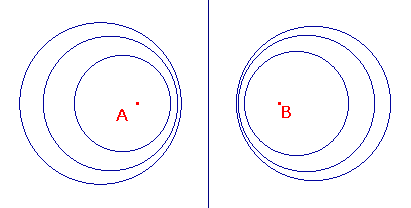


|  |
| Apollonius of Perga
is best remembered for his work on conics (he is responsible for the names parabola, ellipse and hyperbola), but he also investigated other families of curves. One such has particular relevance to inversive geometry.
Definition
If we choose k = 1, then we get the perpendicular bisector of AB, i.e. a line. |  |
Apollonius Theorem
Notice that the first part of the theorem, shows that each family A(A,B) contains
We use complex numbers as "coordinates" (so the point (a,b) in R2 For typographical reasons, we will use z* to denote the complex conjugate of z.
Immediately we see that inversion in the i-line given by the real axis + Ñ is |
This is a fuller form of the theorem |
|
Inversion in the i-line |z| = r is also easy to describe,
|
|
|
We are now in a position to give a much neater proof that inversion maps i-lines
The Second Inversion Theorem
Suppose that L and C are i-lines, and that t denotes inversion with respect to C.
|
| Main inversive page |